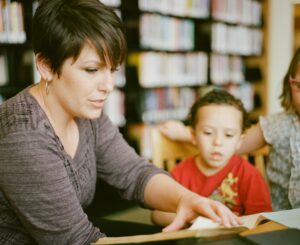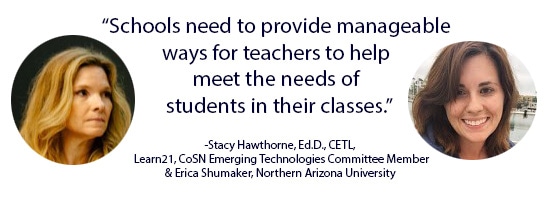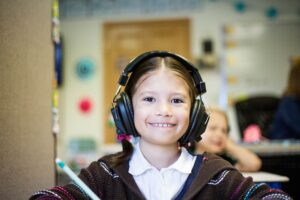Part of a Blog Series from the Emerging Technologies Committee Leveraging Technology for Improving School Wellness and Safety
Educators have aptly noted that the number of students coming to school with increasing mental health needs has increased in the last five years. With rising rates of depression and anxiety students are coming to schools in need of educators who are able to meet them where they are and help them access classroom content while working through their mental health needs. While educators cannot take the place of a mental health counselor they can provide a space for students to explore and learn through effective integration of Social and Emotional Learning techniques.
Social Emotional Learning (SEL) is defined by the Committee for Children as the process of developing the self-awareness, self-control, and interpersonal skills that are vital for school, work, and life success. Research has confirmed that SEL leads to better academic performance, less emotional distress, and a decrease in conduct issues such as incidences of violence, substance abuse, and aggression. With growing interest in SEL has come more demand for emerging technologies to help educators meet the social and emotional needs of their students. SEL is learning that can happen on many levels within a school community.
Technology to support SEL in the classroom 
One of the first ways that educators can help students increase their social and emotional awareness is through seamless integration in classroom lessons. With the use of rising technology the workload on teachers to create new lessons is decreasing while the ability to help students identify their needs is increasing.
Simple ways to help students on a regular basis are with quick check-ins. Products like Microsoft Teams’ Reflect or Nearpod’s interactive presentation allow students to share where they are emotionally as they enter the classroom or during a lesson. Both of these platforms allow students to identify their emotional or mental state without the pressure of sharing out loud amongst their peers. In real time teachers can see the emotional barometer of their class. They can check in one on one with students who may have expressed experiencing difficulty and address any issues right away. Teachers can also gauge how a class might be doing with new material and make adjustments as needed to meet the needs of their students.
These techniques are simple but effective ways to help students identify their emotions and feelings. Allowing students to explore their feelings and emotions allows them to come to class feeling safe which leads to higher levels of learning and engagement with course content.
Technology to support SEL at the district level
The job of helping students grow is not limited to the role of teachers. It is a whole school endeavor. The Gwinnett County Public School has implemented technology to drive data and help students find career paths that meet their interests while leading to increased student self-efficacy and self-advocacy, both of which are related to healthy emotional intelligence.

Starting at the elementary and middle school levels, teachers use their Learning Management System, LMS, to record student preferences and class selections. This data is helpful for students as they reach high school and have a choice of over 60 career pathways to pursue within the district. These career pathways can lead to high paying jobs that require a high level of skill and are in high demand. Not only does GCPS have different career pathways for students, they have a number of high interest high schools that allow students to study more in their chosen career clusters, such as STEAM or Health Sciences.
This data-informed practice improves student engagement and supports adaptive methods to assess students’ learning needs. Some ways technology can support personalization and multi-tiered systems of support are:
- Data collection shows if students are in need of extra support.
- Information that allows students to see that they are doing well in a subject and prompts them to take more advanced courses in topics students enjoy.
- Automated or adaptive platforms that can identify the need for remediation or acceleration and can provide digital resources to educators and students.
- Learning Management Systems provide educators with the ability to help students while not increasing their already overfilled workload.
- Expanded universal screening technology identifies students earlier and gets services to them quicker.
Technology to support SEL in Family Communication
Communication between the school and caregivers is important to support each student’s success and mental health. Technologies are able to connect school and home more effectively and efficiently than ever. As a result of the increased need for effective communication with families, many districts decided to update their Learning Management Systems and/or purchase additional communication tools. We spoke to districts that have recently upgraded their LMS and/or improved their communication within the whole school system. Some of the features that facilitate better communication between parents, teachers and students are:
- 24/7 Learning: Having an LMS that allows for 24/7 learning allows students to work on their own time and for caregivers to be able to help at home.
- Transparency: Having materials easily accessed online allows families to view and access classroom activities, assignments, attendance records and other important material to support their student at home.
- Ease of Access: Having one communication platform for all communications (newsletters, text messages, emails, attendance).
- Improved Accessibility: Using technology allows parents to translate text into the language that is easiest for them to understand. Additionally, accessibility tools like Ally allow students to view instructional materials in a format that is best suited for their learning style or needs.

Social Emotional Learning Technology Solutions
Implementing SEL programs can be challenging for educators and schools. While it can take time for teachers, schools, and families to buy in to implementing SEL resources the rewards are worth the investment. Gwinnett County Public Schools, Greenville Public Schools (GPS), and Bartholomew Consolidated School Corporation (BCSC) shared their experience in implementing their technology driven SEL solutions.
- Establish an SEL Department: At GCPS, the newly formed SEL department is responsible for identifying what materials and resources a school needs in order to meet the needs of educators, students and parents.
- Pilot the program: Mobilize a small team of teachers who are invested and support the idea of incorporating social and emotional learning to implement the program to troubleshoot any issues before it is released to the whole school/district.
- Use a double feedback loop: GCPS implemented a SEL committee made up of teachers, administrators, district staff, and a separate student committee that weighs in on the decisions (curriculum purchased etc.).
- Incorporate all stakeholders: BSCS reached out to public, private, and social sectors in their community to form a coalition of stakeholders invested in improving SEL support for students. BSCS is using an asset based approach to tap into all the resources in their community. This coalition has already supported the purchase of mindfulness programs and learning materials with embedded SEL components.
- Align and coordinate with School Counseling programing: Utilize the stakeholders at your school who are licensed professionals to help educators implement social and emotional learning in a way that is manageable for classroom teachers and yields results for students.
Now more than ever it is important to have systems in place that allow for students to grow socially and emotionally. Schools need to provide manageable ways for teachers to help meet the needs of students in their classes. Allowing for more emotional identification, personalization, and multi-tiered systems of support are just three ways that schools can begin to help students. Working with technology that is rooted in SEL allows students to drive their own learning and create pathways to their future while also forging stronger connections between home and school.
Authors: Stacy Hawthorne, Ed.D., CETL, Learn21, CoSN Emerging Technologies Committee Member
and Erica Shumaker, Northern Arizona University
Published on: March 9, 2023
EdTechNext 2023 Blog series:
Download the resource here.
Listen to the Education meets the universe: The promise and the worry Webinar Archive organized by the Emerging Technologies Committee.
CoSN is vendor neutral and does not endorse products or services. Any mention of a specific solution is for contextual purposes.



